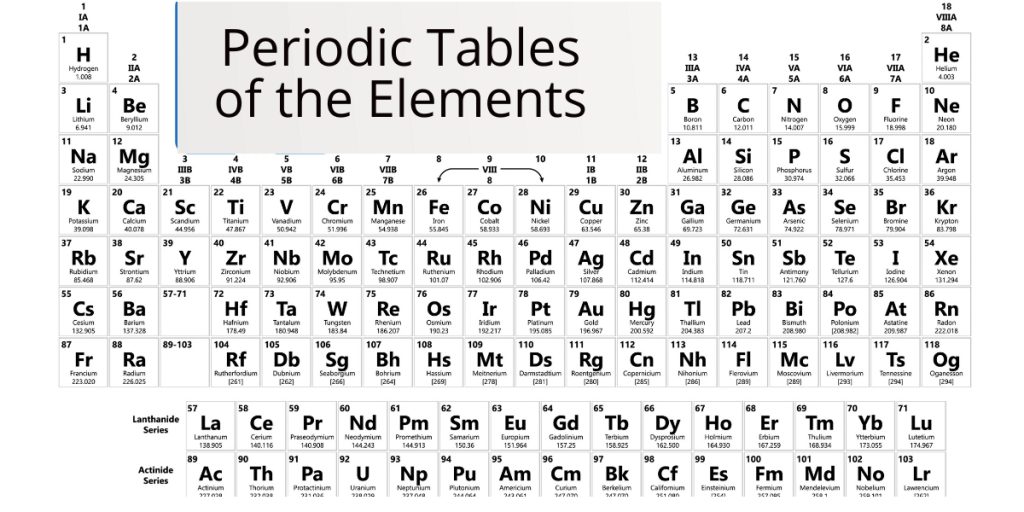The Periodic Table and Electronegativity: An In-Depth Exploration
The periodic table is one of the most fundamental tools in chemistry, showcasing the various elements in an organized manner. Each element is defined by its atomic structure and properties, among which electronegativity plays a crucial role. This article will delve into the concepts of electronegativity, its significance in chemical bonding, and how it relates to the structure of the periodic table.
Understanding the Periodic Table
The periodic table is a systematic arrangement of elements based on their atomic number, electron configurations, and recurring chemical properties. This organization allows chemists to predict the characteristics of elements and how they interact with one another.

Structure of the Periodic Table
The periodic table is divided into rows (periods) and columns (groups or families):
- Periods: Horizontal rows that represent the number of electron shells in the atoms of the elements.
- Groups: Vertical columns where elements have similar chemical properties due to the same number of electrons in their outer shell.
Table 1: Overview of Periodic Table Groups
| Group Number | Group Name | Key Characteristics |
|---|---|---|
| 1 | Alkali Metals | Highly reactive, one electron in outer shell |
| 2 | Alkaline Earth Metals | Reactive metals, two electrons in outer shell |
| 17 | Halogens | Very reactive nonmetals, seven electrons in outer shell |
| 18 | Noble Gases | Inert gases, full outer electron shell |

What is Electronegativity?
Electronegativity is a measure of an atom’s ability to attract and hold onto electrons when forming bonds. It helps predict how different atoms will interact with one another, influencing the nature of the resulting molecules.
The Pauling Scale
One of the most commonly used scales to quantify electronegativity is the Pauling scale, developed by Linus Pauling. On this scale, the most electronegative element is fluorine, assigned a value of 4.0, while cesium is among the least electronegative, with a value of 0.7.
Why Electronegativity Matters
Understanding electronegativity is essential for predicting the behavior of atoms in chemical reactions. As chemist Linus Pauling once stated:
“The electronegativity of an element is a measure of its ability to attract electrons in a bond.”
This attraction can lead to the formation of different types of bonds, primarily covalent and ionic.
Electronegativity and Chemical Bonds
Types of Chemical Bonds
- Covalent Bonds: Formed when two atoms share electrons. The degree of sharing can vary based on their electronegativities.
- Ionic Bonds: Occur when one atom donates electrons to another, leading to the formation of charged ions.
Electronegativity Differences
The difference in electronegativity between two bonded atoms determines the type of bond that will form:
- Nonpolar Covalent Bond: If the difference is less than 0.4, the electrons are shared equally.
- Polar Covalent Bond: A difference between 0.4 and 1.7 indicates unequal sharing, resulting in partial charges.
- Ionic Bond: A difference greater than 1.7 typically leads to the formation of ions.
Table 2: Electronegativity Values of the first 20 elements
| Element | Symbol | Electronegativity (Pauling Scale) |
|---|---|---|
| Hydrogen | H | 2.1 |
| Helium | He | N/A |
| Lithium | Li | 1.0 |
| Beryllium | Be | 1.5 |
| Boron | B | 2.0 |
| Carbon | C | 2.5 |
| Nitrogen | N | 3.0 |
| Oxygen | O | 3.5 |
| Fluorine | F | 4.0 |
| Neon | Ne | N/A |
| Sodium | Na | 0.9 |
| Magnesium | Mg | 1.2 |
| Aluminum | Al | 1.5 |
| Silicon | Si | 1.8 |
| Phosphorus | P | 2.1 |
| Sulfur | S | 2.5 |
| Chlorine | Cl | 3.0 |
| Argon | Ar | N/A |
| Potassium | K | 0.8 |
| Calcium | Ca | 1.0 |
Notes:
- Values marked as “N/A” indicate that noble gases do not typically form bonds and therefore do not have defined electronegativity values.
- Electronegativity values increase across a period and decrease down a group in the periodic table.
Trends in Electronegativity
Electronegativity values are not random; they follow specific trends in the periodic table:
- Increases Across a Period: As you move from left to right across a period, electronegativity generally increases due to the increasing nuclear charge, which attracts electrons more strongly.
- Decreases Down a Group: As you move down a group, electronegativity typically decreases because additional electron shells increase the distance between the nucleus and the outermost electrons, reducing the attractive force.
Practical Applications of Electronegativity
Understanding the electronegativities of different elements is essential in various fields of chemistry and materials science. Here are some applications:
- Predicting Molecular Polarity: By knowing the electronegativities of the atoms in a molecule, chemists can predict its polarity and solubility properties.
- Understanding Acid-Base Behavior: Electronegativity plays a role in the strength of acids and bases. More electronegative atoms tend to stabilize negative charges, making certain acids stronger.
- Material Design: In materials science, electronegativity influences the choice of materials for specific applications, such as semiconductors.
Conclusion
The relationship between the periodic table and electronegativity is a cornerstone of modern chemistry. Understanding how these concepts interrelate allows scientists to predict and manipulate chemical behavior effectively. As research continues to evolve, the insights gained from electronegativity will undoubtedly lead to new discoveries and innovations.
For further reading, resources like BYJU’s provide valuable insights into the periodic table and electronegativity, helping students and enthusiasts alike grasp these fundamental concepts.
References
- Pauling, Linus. The Nature of the Chemical Bond. Cornell University Press, 1960.
- Zumdahl, Steven S. Chemistry. Cengage Learning, 2013.
- “Periodic Table of Elements.” BYJU’S, https://byjus.com/periodic-table/.

